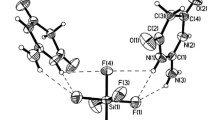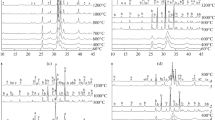Abstract
The formation of crystalline calcium hydroxyapatite from solutions of calcium and phosphate ions and the inhibition of calcium hydroxyapatite crystal growth by polyphosphonates and polyphosphates have been studied. The polyphosphonates, disodium ethane-1-hydroxy-1,1-diphosphonate and disodium dichloromethane diphosphonate, are effective inhibitors of calcium hydroxyapatite crystal growth. The polyphosphates are also effective inhibitors of calcium hydroxyapatite crystal growth as long as the required level of intact polyphosphate is present in the system. However, because of their hydrolytic instability, which is enhanced by high temperature, low pH, and certain enzymes, the concentration of the polyphosphate decreases with timein vitro, and its activity as an inhibitor is lost. In contrast to the polyphosphates, the polyphosphonates are hydrolytically stable. The polyphosphonates are chemisorbed on the surface of the microcrystallites of calcium hydroxyapatite and, in the manner of other known crystal growth poisons, thus prevent further crystal growth. The stability of the polyphosphonates and their chemisorption on apatite suggest their use in medical and dental applications involving pathological calcium and phosphate metabolism.
Résumé
On a étudié la formation de l'hydroxyapatite de calcium cristallin à partir de solutions d'ions de calcium et de phosphate et l'inhibition de la croissance de cristaux de l'hydroxyapatite de calcium au moyen de polyphosphonates et de polyphosphates. Les polyphosphonates, éthane hydroxy-1-diphosphonate-1,1 de disodium et dichlorométhanediphosphonate de disodium, sont inhibiteurs efficaces contre la croissance de cristaux de l'hydroxyapatite de calcium. Les polyphosphates sont aussi inhibiteurs efficaces contre la croissance de cristaux de l'hydroxyapatite de calcium tant que le niveau exigé de polyphosphate intact est présent dans le système. Cependant, à cause de leur instabilité hydrolytique, qui est soulignée par une température élevée, valeur de pH basse, et certaines enzymes, la concentration du polyphosphate diminue avec le tempsin vitro, et son activité comme inhibiteur est perdue. Au contraire aux polyphosphates, les polyphosphonates sont hydrolytiquement stables. Les polyphosphonates sont chimiosorbés sur la surface des microcristallites de l'hydroxyapatite de calcium, ainsi empêchant l'occurrence d'autre croissance de cristaux semblable à l'action d'autres poisons connus de croissance de cristaux. On propose l'extension de cette action sur la formation de l'apatite et cette stabilité des polyphosphonates aux applications médicales et dentaires concernant le metabolisme pathologique de calcium et de phosphate.
Zusammenfassung
Die Bildung des kristallinen Calciumhydroxyapatit aus Lösungen, welche Calcium- und Phosphationen enthalten, und die Hemmung der Bildung von kristallinen Calciumhydroxyapatit durch Polyphosphonate und Polyphosphate wurden untersucht. Polyphosphonate, Dinatriumäthan-1-hydroxyl-1,1-diphosphonat und Dinatriumdichloromethandiphosphonate verhindern das Kristallwachstum des Calciumhydroxyapatits. Die Polyphosphate verhindern ebenfalls das Kristallwachstum des Calciumhydroxyapatits, solange die notwendige Konzentration des nicht hydrolysierten Polyphosphats vorhanden ist. Wegen ihrer hydrolytischen Unbeständigkeit, die durch hohe Temperatur, niedrige pH und bestimmte Enzyme erhöht wird, vermindert sich jedoch die Konzentration des Polyphosphats allmählichin vitro, und ihre Hemmungsaktivität geht verloren. Im Gegensatz zu den Polyphosphaten sind die Polyphosphonate hydrolytisch beständig. Die Polyphosphonate werden an der Oberfläche der Mikrokristallite des Calciumhydroxyapatits chemisorbiert und verhindern, wie andere bekannte Kristallwachstumsgifte, auf diese Weise weiteres Kristallwachstum. Die Beständigkeit der Polyphosphonate und ihre Chemisorption an dem Apatit empfehlen ihren Gebrauch in der ärztlichen und zahnärztlichen Praxis, soweit sie den pathologischen Calcium- und Phosphatstoffwechsel betreffen.
Similar content being viewed by others
References
Bienenstock, A., andA. S. Posner: Calculation of the x-ray intensities of small crystallites of hydroxylapatite. Arch. Biochem.124, 604–615 (1968).
Brown, W. E.: First Conference on Biology of Hard Tissue, Princeton (1966), New York: Academy of Sciences.
Eanes, E. D., I. H. Gillessen, andA. S. Posner: Intermediate states in the precipitation of hydroxylapatite. Nature (Lond.)208, 365–367 (1965).
—, andA. S. Posner: Kinetics and mechanism of conversion of non-crystalline calcium phosphate to crystalline hydroxylapatite. Trans. N.Y. Acad. Sci., Ser. II28, 233–241 (1965).
Fleisch, H., andW. F. Neuman: Mechanism of calcification: role of collagen, polyphosphates, and phosphatase. Amer. J. Physiol.200, 1296–1300 (1961).
Fleisch, H., R. G. G. Russell, S. Bisaz, J. D. Termine, andA. S. Posner: Influence of pyrophosphate on the transformation of amorphous to crystalline calcium phosphate. Calc. Tiss. Res. (in press).
——, andF. Straumann: Effect of pyrophosphate on hydroxylapatite and its implication in calcium homeostasis. Nature (Lond.)212, 901–903 (1966).
—, andI. Frossard: Inhibition of aortic calcification by means of pyrophosphate and polyphosphates. Nature (Lond.)207, 1300–1301 (1965).
—, andM. Allgömer: Effect of condensed phosphates on calcification of chick embryo femurs in tissue culture. Amer. J. Physiol.211, 821–825. (1966).
Glimcher, M. J.: Proc. Internat. Symp. Nucleation Phenomena, Cleveland, Ohio. Meeting reviewed byA. G. Walton. Science148, 1490–1491 (1965).
Irving, J. T., D. Schibler, andH. Fleisch: Effect of condensed phosphates on vitamin D-induced aortic calcification in rats. Proc. Soc. exp. Biol. (N.Y.)122, 852–856 (1966).
Lucena-Conde, F., andL. A. Prat: A new reagent for the colorimetric and spectrophotometric determination of phosphorus, arsenic, and germanium. Anal. chim. Acta16, 473–479 (1957).
MacGregor, J., andW. E. Brown: Blood: bone equilibrium in calcium homeostasis. Nature (Lond.)205, 359–361 (1965).
Martin, J. B., andD. M. Doty: Determination of inorganic phosphate: Modification of isobutylalcohol procedure. Anal. Chem.21, 965–967 (1949).
Newesely, H.: The chemical behavior of calcium polyphosphates in enamel and dentine. Caries Res.1, 1–14 (1967).
Quimby, O. T., andJ. Prentice: Netherlands application No 6, 604, 219. 1-hydroxy-1,1-ethanediphosphonic acid (Procter & Gamble Co.), October 3, 1966.
Schibler, D., andH. Fleisch: Inhibition of skin calcification (calciphylaxis) by polyphosphates. Experientia (Basel)22, 367–369 (1966).
Selye, H.: Calciphylaxis. Chicago: Univ. of Chicago 1962.
Tuchweber, B., andG. Gabbiani: Effect of sodium pyrophosphate on experimental softtissue calcification and hypercalcemia. Canad. J. Physiol. Pharmacol.45, 957–964 (1967).
Walton, A. G., W. J. Bodin, H. Furedi, andA. Schwartz: Nucleation of calcium phosphate from solution. Canad. J. Chem.45, 2695–2701 (1967).
Weber, J. C., E. D. Eanes, andR. J. Gerdes: Electron microscope study of noncrystalline calcium phosphate. Arch. Biochem.120, 723–724 (1967).
Author information
Authors and Affiliations
Rights and permissions
About this article
Cite this article
Francis, M.D. The inhibition of calcium hydroxyapatite crystal growth by polyphosphonates and polyphosphates. Calc. Tis Res. 3, 151–162 (1969). https://doi.org/10.1007/BF02058658
Received:
Issue Date:
DOI: https://doi.org/10.1007/BF02058658




